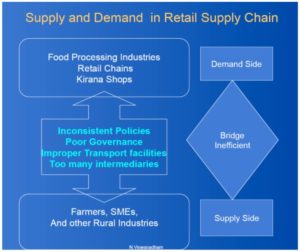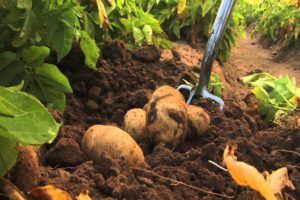SV Agri – Consolidating India’s Potato Supply Chain

Indian agriculture industry is segmented, scattered and primitive. SV Agri is a promising new start-up that is building to streamline the potato supply chain in India. But how should they incorporate climate change in the services that they offer?
India – Agriculture and potato
Agriculture contributes to 13.7% Indian GDP while employing 50% of the population[1]. There has been little progress in streamlining the process since Indian independence in 1947. The various stakeholders are fragmented, disconnected and inefficient. Some of the key issues are – lack of Governance,lack of private capital and involvement, primitive technology and inadequacy of infrastructure (roads, energy, storage facilities)[2].
India stands among the leading agricultural producers in the world, particularly when it comes to potatoes, one of India’s favorite food. India ranks third in the list of major potato producing countries of the world, producing around 25 million tonnes of potatoes (8% of the world’s total production)[3]. The traditional supply chain for potato production is as follows:
Farmer→Consolidator→Wholesaler→Semi Wholesaler→Retailer
Climate Change in India and its impact on potato supply chain
India happens to be one of the most vulnerable countries when it comes to climate change. A warming of 0.5 degC is likely by 2030 and of 2-4 degC by the end of the century. Moreover, increased precipitation is expected with extreme rainfall events, flooding and fewer rainy days[4].
Potato production has a complicated relationship with climate change. The production is projected to increase with increases in local average temperature over a range of 1 to 3 °C, but above this it is projected to decrease[5]. Increased CO2 levels are likely to enhance the photosynthetic rate and reduce water consumption[6]. However, the harm due to expected erratic rainfall overweights the above benefits since “Indian agriculture gambles with monsoons”.
SV Agri – Streamlining potato supply chain in India 
SV Agri, founded by Hemant Kaur and Ganesh Pawar in 2008, provides end to end value chain for smallholder potato farmers in India by delivering necessary inputs at all points of the value chain. It is a relatively small company, operating 125 franchisees in seven Indian states. The firm provides higher quality potato seeds, financing services, pesticides, fertilizers, technical solutions and equipment to farmers, highly technical and effective distribution and packing equipment[7].
How should SV Agri become resilient to climate change threat to potato production?
One of the biggest strengths that SV Agri has is being a pioneer in consolidating the potato supply chain in India and designing effective solutions at each step of the value chain. This gives them the edge of being able to design resources as they keep in mind the potential climate change impact. Since they are one of the very few companies focussed in this area, they have the potential to set an example for the entire industry moving forward in how to integrate climate change with the design of agricultural systems. They are addressing farmers by providing high quality inputs (seeds, fertilizers etc) from the start. In addition to a direct physiological effect on potato yield, climate change may indirectly affect potato production and productivity through the negative impact of pest and diseases. However, chemical control is emerged as management option for late blight of potato. Only 13.9 % of the respondent depends on chemical control[8]. SV Agri is also tackling this by partnering with the best in agro chemicals industry to supply pesticides to small farmers.
Another component of the supply chain that gets heavily impacted is the change in consumption pattern due to the lack of year long availability of potatoes, particularly in India where storage facilities are at a subpar level. SV Agri offers cutting edge solutions to this problem – controlled bulk storage facilities with temperature regulation and air distribution system as well as box storage facilities for transportation. They are also providing process equipment and process automation to increase the utilization and reduce wastage[9]. They also provide consulting services to farmers, thereby reducing variables in the conventionally highly uncontrolled environment which Indian agriculture is used to.
Going forward
SV Agri is a relatively new fast growing company, with limited current outreach. They are at an early stage and are more focussed on growing rather than becoming more sustainable and resilient to climate change. While some of their offerings and designs address those issues, it isn’t their primary priority.
They should work towards making the chain more compact and less scattered. This would enable them to have a higher impact and also make the process more controlled for possible future technological changes and adaptations, both in terms of improving yield and catering to climate change.
Also, another part of the supply chain that can get heavily affected due to climate change is logistics and infrastructure (roads, transportation, power, telecommunication) which SV Agri has no focus on.
Questions
- How should SV Agri get higher market share?
- How should they finance additional technology, specifically centered around climate change?
(786 words)
[1] N. Viswanadham (2013)The Food Supply Chain In India: Untapped Comparative Advantage http://drona.csa.iisc.ac.in/~nv/90Foodsupplychain05102013IITKh.pdf
[2] Sahay B.S, Mohan R.(2003) “Supply chain management practices in Indian industry”, International Journal of Physical Distribution & Logistics Management, Vol. 33 Issue: 7, pp.582-606, https://doi.org/10.1108/09600030310499277
[3] Meeta Punjabi (2015) “The potato supply chain to PepsiCo’s Frito Lay” http://www.fao.org/fileadmin/user_upload/ivc/PDF/Asia/15_Punjabi_potato_contract_farming_for_Pepsi_India_formatted.pdf
[4] National Intelligence Council (2009) ‘India: The Impact of Climate Change to 2030” https://www.dni.gov/files/documents/climate2030_india.pdf
[5] A. J. Haverkort, A. Verhagen (2008) “Climate Change and Its Repercussions for the Potato Supply Chain” Potato Research (2008) pp.223–237 DOI 10.1007/s11540-008-9107-0 https://link.springer.com/article/10.1007/s11540-008-9107-0
[6] van der Waals, J.E., Krüger, K., Franke, A.C. et al. Potato Res. (2013) 56: 67. https://doi.org/10.1007/s11540-013-9231-3
[7] Vikki Tam – Bain & Company (2014) “Growing Prosperity: Developing Repeatable Models to Scale the Adoption of Agricultural Innovations” http://www.bain.com/publications/business-insights/growing-prosperity.aspx
[8] A, Shibabaw & Alemayehu, Getachew & Y, Desalegn & E, Adgo & Tewodros, Yoseph & Germer, Jörn & Asch, Folkard & Merene, Yeshitla & Freyer, Bernhard. (2014). “ Exploratory survey on climate change effects, value chain processes and supportive services: Case study from Potato based farming systems of AWI-Zone, Ethiopia”. International Journal of Science Innovations and Discoveries. 2. 615-621. https://ijair.org/administrator/components/com_jresearch/files/publications/IJAIR_441_Final.pdf
[9] http://svagri.co.in/potato-supply-chain Accessed 13 Nov 2017







The demand for services such as SV Agri is providing is clearly already quite large (with India contributing 8% of global potato production) and the demand is likely to increase as more smallholder Indian farmers experience the effect of climate change. SV Agri’s current product offering helps farmers respond to climate change and mitigate the risks of erratic weather patterns. However, this is a reactive product. I wonder if SV Agri has considered offering services to help farmers reduce their carbon emissions. At scale, I wonder if reduced emissions from Indian potato farms could move the needle for climate change on the whole.
When considering how SV Agri could gain market share, I wonder whether they’ve considered vertically integrating with their customers and consolidating the farms themselves. The vast majority of farms in India are smallholder farms, the average size of an Indian farm is roughly 1 Hectare (2.47 Acres). At this size, many farms are no longer financially viable because of the necessary high fixed costs. I question whether SV Agri could be more successful when it comes to protecting Indian agriculture against climate change and improving potato yields if they owned the farms themselves, employing farmers but controlling decision rights. Understandably this would be a different business model entirely for SV Agri, and they would likely face cultural and regulatory barriers (assuming that these are the barriers causing the smallholder-farm trend in the first place).
SV Agri reminds me of the marketplace cases we are studying in the current TOM module. They seem to add value by adding efficiency to a fractured marketplace.
How sustainable is their position in the marketplace? We saw with our ride sharing case that Uber was adding value, but the value they add was easy for Lyft to replicate.
Should SV Agri shift to a more asset-light or asset-heavy model? I’m thinking about our Airbnb and Marriott discussion. There seems to be advantageous to both approaches. On the one hadn’t SV Agri could enter the farming market themselves, thereby securing some of the advantages they are providing farmers. On the other hand this reduces the advantages they have gained.
Will climate change improve SV Agri’s market position? This is the most compelling question in my mind. SV Agri seems to be positioning themselves to benefit from climate change. This seems to be a strong thesis to place a bet on based on the consensus in the scientific community.
SV Agri’s product offering seems based on improving yield by assuming climate change and optimizing the chemical makeup of the potato supplies (e.g., seeds, fertilizer, etc). I question this business model’s sustainability for a few reasons:
1) Few, if any, farmers buy products in advance of an issue. Although climate change is happening rapidly (by global terms), it is still projected to take decades. Why would farmers, particularly poor ones, invest now?
2) By the time climate change has a significant impact, I think it likely that major crop producing companies (e.g., Dow) would also genetically engineer crops for the now-higher temperatures. What advantage would SV Agri have over them?
In reading about SV Agri’s offering of “better seeds” and thinking about how they could capture market share, I was reminded of the Indigo case from the innovation module. Indigo is developing seeds that will thrive under various water conditions, and this type of seed would be ideal as the climate changes in India. As these seeds are developed, SV Agri could gain market share by offering these seeds that will best perform under the changing conditions. A strong product portfolio through partnerships could be a competitive edge for SV Agri.
I believe another important factor for SV Agri’s ongoing success as the climate changes is a commitment to diversification. Climate change will affect different geographies across the Indian subcontinent in different ways, so they need to diversify the idiosyncratic risk of these various geographies by sourcing potatoes from all of the various growing locations. I also think they should begin to diversify into different crops for two reasons. First, climate change will affect various crops in different ways, and SV Agri can mitigate some risk by diversifying. Also, if some growers are unable to grow potatoes due to climate change, SV Agri can offer them different seeds/services because they will have already established a working relationship with the growers. Both of these effects of diversification will reduce SV Agri’s climate change risk.
Though you mentioned that SV Agri is more focused on growth than preparing for the negative effects of climate change at this time, I can’t help but think about how they could fund the needed investment when their focus shifts. This reminds me of one of our very first cases (the cardiac hospital in India) and how they created an affordable health insurance plan to encourage individuals to engage in preventative care in order to prevent the incidences of individuals with catastrophic (and very expensive) problems. Given that some investment in the development of better crops/tools/etc. now may help to enable the industry to continue to thrive and reduce the potential for farmers losing their livelihood due to climate change, I think it would be worthwhile for SV Agri to look into creating a program that would charge a small, affordable fee to the farmers they currently work with. In return, SV Agri could provide these farmers with the tools and resources that will enable them to obtain more consistent and dependable yields despite the changing environmental conditions.